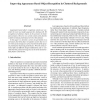Free Online Productivity Tools
i2Speak
i2Symbol
i2OCR
iTex2Img
iWeb2Print
iWeb2Shot
i2Type
iPdf2Split
iPdf2Merge
i2Bopomofo
i2Arabic
i2Style
i2Image
i2PDF
iLatex2Rtf
Sci2ools
ICPR
2000
IEEE
2000
IEEE
Improving Appearance-Based Object Recognition in Cluttered Backgrounds
Appearance-based object recognition systems are currently the most successful approach for dealing with 3D recognition of arbitrary objects in the presence of clutter and occlusion. However, no current system seems directly scalable to human performance levels in this domain. In this paper we describe a series of experiments on a previously described object recognition system that try to see which, if any design axes of such systems hold the greatest potential for improving performance. We look at the potential effect of different design modifications and we conclude that the greatest leverage lies at the level of intermediate feature construction.
| Added | 31 Jul 2010 |
| Updated | 31 Jul 2010 |
| Type | Conference |
| Year | 2000 |
| Where | ICPR |
| Authors | Andrea Selinger, Randal C. Nelson |
Comments (0)

